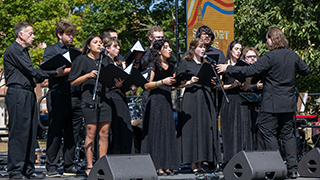Students Participate in South Orange Tree Project
Thursday, October 18th, 2018

With the Environmental Commission's goal to identify and inventory the 10,000-12,000 public/street trees in South Orange, students were happy to share their insight on tree identification and data collection from the past couple of weeks. With the deciduous trees losing all their leaves soon, the concern was that the South Orange Village tree project could start, but would be stalled during the winter. Helan Thomas, a Junior majoring in Biology and Environmental Studies, offered the advice to "count all the trees and measure DBH (diameter) first, during the winter, and then the work in the Spring can be the identification, when the leaves grow back." Bill Haskins was thrilled to hear about this two-step approach and is excited to incorporate it during data collection for the trees along streets and in public parks. He is also interested in doing an overall tree canopy analysis, to better communicate the benefits of the trees to residents and for grant writing (increased property values as well as ecological benefits). Walter Clarke proposed that the thousands of public/street trees be categorized as infrastructure and that the public works budget include an allocation for maintaining and pruning the trees. "We have many large, old ash trees in town and they need the emerald ash borer treatment, to prevent the beetles from killing the trees. This can cost hundreds of dollars per tree."
In the coming seasons, the Environmental Studies students will be collaborating with the Bill, Walter and Barbara, to help with their tree project. With students like Helan Thomas involved, brilliant ideas and creative solutions can be implemented on campus and in the larger South Orange community. Counting, researching, identifying, and mapping 10,000 trees? Yes, Seton Hall students can help do it! For more information about the TIIP Environmental Studies project, please email [email protected]






